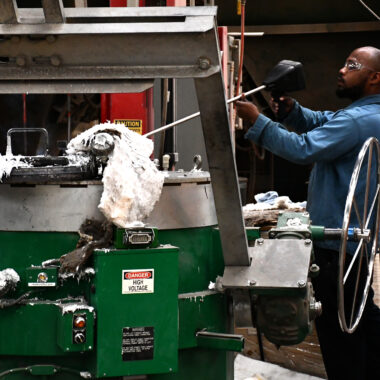Study the Globe of Aluminum Casting: Comprehending the Different Approaches
Light weight aluminum spreading is a basic process in the manufacturing market, with numerous techniques utilized to produce elaborate and precise parts. Recognizing the various methods utilized in aluminum casting can give useful understandings into the capabilities and restrictions of each method. From the standard sand casting technique to the advanced die spreading procedure, each method uses one-of-a-kind benefits relying on the needs of the job. Exploring these varied methods can use a thorough sight of the opportunities within the globe of aluminum casting and exactly how each strategy adds to forming the modern manufacturing landscape.
Sand Casting Method
Sand spreading, a widely-used approach in light weight aluminum casting processes, involves creating molds made of compacted sand for putting liquified steel. When the mold is ready, it is securely positioned in a flask and molten aluminum is put right into the tooth cavity.
After the metal has cooled down and strengthened, the sand mold and mildew is broken away to reveal the light weight aluminum spreading. Sand casting enables the manufacturing of intricate shapes and large components that might be tough or costly to generate utilizing other approaches. It is likewise a sustainable method as the sand can be reused and made use of several times, decreasing waste in the casting procedure.
Long-term Mold Strategy

One significant advantage of the Permanent Mold And Mildew Technique is the improved dimensional accuracy it offers. The metal mold and mildew permits for tighter resistances and better information in the final aluminum castings compared to sand spreading approaches. This accuracy makes it a favored option for applications where tight dimensional control is essential, such as in the aerospace and automobile industries.

Die Casting Process

Investment Casting Method
Making use of an see this accuracy casting approach, Financial investment Casting Technique involves developing complex aluminum parts by putting molten steel into a ceramic mold and mildew. This process, also recognized as lost-wax casting, starts with the development of a wax pattern of the desired component (aluminum casting).
The next action involves putting the molten light weight aluminum into the ceramic mold and mildew. The aluminum loads the tooth cavity left by the wax pattern, taking its form exactly. This method is preferred for its ability to create complex shapes with high precision and a smooth surface coating. Investment spreading is commonly utilized for manufacturing elements in sectors where limited resistances and elaborate layouts are required, such find out as aerospace, vehicle, and clinical equipment. The convenience and accuracy of the Investment Casting Technique make it a useful technique worldwide of aluminum casting.
Lost Foam Spreading Technique
Having actually checked out the complex precision of Investment Casting Approach, the focus currently moves to the ingenious technique of Lost Foam Casting in light weight aluminum part production. Lost Foam Casting, also recognized as evaporative pattern spreading, is a contemporary strategy where a foam pattern of the desired component is produced and then covered with a refractory product.
Furthermore, Lost Foam Casting is a cost-efficient process as it lowers the need for cores and permits for the production of light-weight components. In spite of its benefits, Lost Foam Casting needs careful control of the casting procedure to prevent flaws and ensure quality elements.
Verdict
Finally, light weight aluminum spreading provides a range of approaches such as sand casting, irreversible mold and mildew technique, die casting, financial investment spreading, and lost foam casting. Each technique has its very own benefits and applications, making aluminum casting a versatile and commonly utilized procedure in numerous industries. Understanding the differences in between these approaches is crucial in selecting the most appropriate spreading method for details manufacturing needs.
Sand spreading, a widely-used method in aluminum casting processes, involves producing molds made of compacted sand for pouring molten metal. aluminum casting.The Long-term Mold Method, like sand casting, is one more common technique utilized in aluminum casting processes, offering distinct benefits in terms of mold and mildew reusability and dimensional precision. The steel mold and mildew enables for tighter tolerances and finer details in the last light weight aluminum spreadings contrasted to sand casting methods. The two main kinds of die spreading are chilly chamber die casting and hot chamber pass away spreading, each ideal for various types of aluminum alloys.In verdict, aluminum casting provides a range of methods such as sand spreading, irreversible mold technique, pass away spreading, financial investment spreading, and lost foam casting